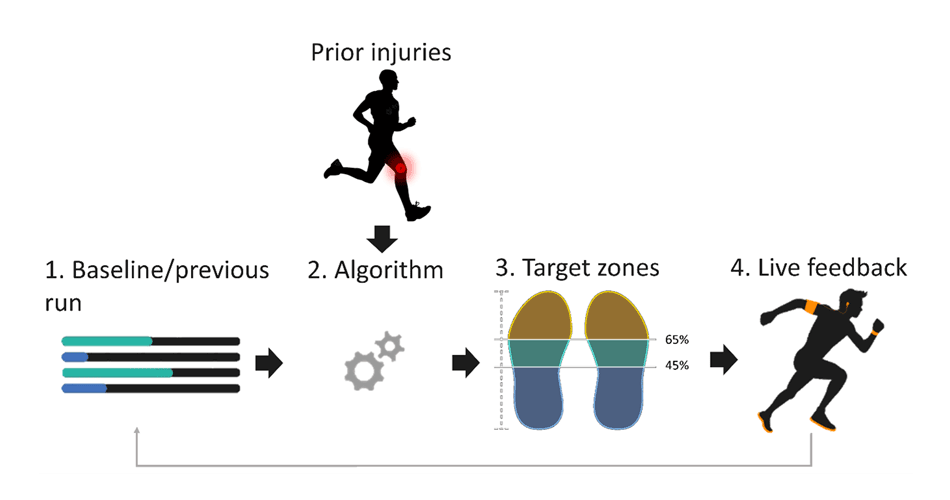The Effect of Wearable-Based Real-Time Feedback on Running Economy and Running Technique
An increasing number of runners use wearables that provide real-time feedback. But is this feedback actually effective at improving performance and reducing injury risk? In two studies, we have attempted to answer these questions 1 2. In this blog, I will briefly discuss the effects of wearable-based real-time feedback on running economy and running technique.
Why this study?
First, why this study: Studies have shown lab-based real-time feedback to change running technique effectively but typically show no effect on running economy. One of the reasons for this may be that the study durations were too short for the changed running technique to also lead to improved running economy.
Further, it remains unknown if wearable-based feedback can effectively change running technique as opposed to lab-based feedback.
What did we do?
40 runners received an instrumented insole connected to an application on the phone and performed 6 months of in-field training with (real-time feedback group) or without (control group) wearable-based real-time feedback on running technique and speed.
Running economy and running biomechanics were measured in a lab (Figure 1) without feedback pre- and post-intervention at four speeds.

Figure 1: Impression of the Caren lab
Key findings
Both groups significantly reduced their energetic cost by an average of −6.1% and −7.7% for the control and intervention groups, respectively. However, the reduction in energy cost did not significantly differ between groups overall (left panel, Figure 2).

Figure 2. Pre- and post-test values for running economy (A) and contact time (B) at the comfortable running speed for each group. Thick lines depict the mean effect, while thin lines depict a single individual. (C) depicts the relation between changes in contact time and running economy at each speed, with symbols representing the individuals grouped per speed and the lines depicting the best-fit linear regression line. The variance in changes in running economy explained by changes in contact time (R2 values) was typically low to moderate (0.14 for 2.78 m∙s-1, 0.34 for 3.33 m∙s-1, 0.33 for comfortable speed, and 0.34 for 10% faster).
Similarly, although there were significant changes in spatiotemporal metrics (middle panel, Figure 2), their magnitude was minor and did not differ between the groups. There were also no significant changes in running kinematics within or between groups (Figure 3).

Figure 3: Pre- and post-sagittal-plane knee joint angle during the comfortable running speed in the control group (A) and intervention group (B). Plot C depicts the difference in knee joint angle from pre to post-measurement for each group. Statistical parameter mapping showed no differences within each group or between groups.
Why was feedback not more effective than no feedback?
The primary reason is that the target zones may not have been different enough from the self-selected gait (the target zones were relatively similar to the self-selected gait for most runs; Figure 4).

Figure 4. The wearable recorded the cadence and foot strike index during the in-field sessions in two participants. When low and upper target zones are indicated (horizontal black lines), there was real-time feedback provided on that metric during the specific session. For example, in panel B, session 10 was a session with real-time feedback on cadence, with an upper target zone of 162 and a lower target of 142 steps∙min-1. Similarly, session 12 was a session with real-time feedback on the foot strike index, with an upper target zone of 33% and a lower target of 0%. Shaded areas indicate a baseline run without any real-time feedback.
Note that for the participant depicted in panel A, the target zones for cadence and footstrike index are very similar to the typical variation seen in the first four baseline sessions (shaded areas), suggesting the absence of effects on running biomechanics could be due to the target zone not being different enough from the baseline variation to induce acute and thereby long-term changes in running technique. For B, the cadence target zone for sessions 29 and 33 is higher than the typical cadence, and the participant also adopted a slightly higher cadence during these sessions. Yet after these sessions, cadence returned to the typical value, thus suggesting no learning effect. Finally, in sessions 36 and 40, the footstrike index target zones were also higher than the typical values, but the participant did not run within the target zone, potentially also contributing to the absence of changes in running biomechanics with the wearable relative to the control group.
However, alterations in running biomechanics beyond typical session-to-session variation were observed during some sessions with feedback, as shown in Figure 4. A second explanation is, therefore, that participant may have relied on feedback & did not learn to alter their gait without feedback in the lab. Such a finding has implications for motor learning and the design of feedback in wearables
There are many more interesting findings in the paper, including:
- Correlation change in running biomechanics & running economy
- Effects of feedback on the comfortable running speed
- Relationship between lab-based & in-field comfortable running speed
- Etc.
For more details, read the paper here for free: https://onlinelibrary.wiley.com/doi/10.1111/sms.14565
References
- Van Hooren B, Plasqui G and Meijer K. Changes in running economy and running technique following 6 months of running with and without real-time feedback by wearable technology. Scandinavian Journal of Science and Medicine in Sports 2024; 34: e14565. DOI: 10.1111/sms.14565.
- Van Hooren B, Plasqui G and Meijer K. The Effect of Wearable-Based Real-Time Feedback on Running Injuries and Running Performance: A Randomized Controlled Trial. Am J Sports Med 2024; Epub ahead of print: 3635465231222464. 20240129. DOI: 10.1177/03635465231222464.











Responses